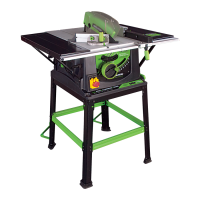WARNING: Freehand cutting
is a major cause of accidents.
g) Never attempt to free a stalled blade
without first turning the saw off. Turn the power
off immediately to prevent damage to the motor.
h) Provide adequate support for long or
wide workpieces.
i) Avoid awkward operations and hand
positions where a slip could cause your
hand to move into the blade.
WARNING: Before using your table saw
it is important that you read and understand
these safety rules. Failure to follow these rules
could result in serious injury to the operator
or damage to the table saw.
a) Always use the blade guard. The blade
guard must always be used in every operation.
b) Hold the work firmly. Against the mitre
gauge or rip fence.
c) Always use push-sticks or push blocks
to feed the workpiece past the saw blade.
d) Keep guards in place and in working
order. Always ensure that the riving knife is
fitted and correctly adjusted. Inspect the riving
knife regularly and replace it if it is worn. Use
only a genuine Evolution riving knife as this is
a dedicated component for this machine.
e) Remove adjusting keys and wrenches.
Form the habit of checking to see that keys
and adjusting wrenches are removed from
the machine before turning it on.
f) Do not use in dangerous environment.
Do not use power tools in damp or wet
locations, or expose them to rain. Keep work
area well lit. Keep the area well ventilated.
g) Keep children away. All children and
visitors should be kept at a safe distance from
the work area.
h) Do not use High Speed Steel
(HSS) blades. Use only saw blades for
which the maximum possible speed is
not less than the maximum spindle speed
of the tool and the material to be cut.
i) The push stick or push block should
always be stored with the machine when
not in use.
j) Connect the saw to a dust collection
device when sawing wood. The operator
should be informed of the factors that
influence exposure to dust e.g. type of
material being cut and the importance of local
extraction (capture or source) and the proper
adjustment hoods/baffles/chutes.
k) Use proper extension cord. Make sure
any extension cord is in good condition.
When using an extension cord, be sure to use
one heavy enough to carry the current your
machine will draw. An undersized cord will
cause a drop in line voltage resulting in loss
of power and possible overheating.
l) Always use safety glasses. Also use a
face or dust mask if the cutting operation is
dusty. Everyday eyeglasses only have impact
resistant lenses, they are NOT safety glasses.
m) Maintain tools with care. Keep tools sharp
and clean for best and safest performance.
Follow instructions for lubricating and
changing accessories.
n) Disconnect from the power supply before
servicing, cleaning or and when changing
accessories, such as blades.
o) Use recommended accessories. Only use
genuine Evolution accessories.
p) Check for damaged parts. Before
further use of the tool, a guard or other part
that is damaged should be carefully checked
to determine that it will operate properly
and perform its intended function - check for
alignment of moving parts, binding of moving
parts, breakage of parts, mounting, and any
other conditions that may affect its operation.
A guard or other part that is damaged should
be properly repaired or replaced.
q) Keep hands out of the
path of the saw blade.
r) Never reach around the saw blade.
s) Turn off machine and wait for
saw blade to stop before making
any fence adjustments.
t) Never pull or carry the tool by the power
cord. Carrying or pulling the tool by the power
cord could cause damage to the insulation
or the wire connections resulting in the
possibility of electric shock or fire.

